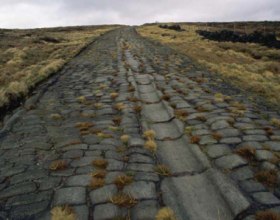英格兰的罗马路

英国最早的道路是由罗马军团修建的,他们有自己的测量员、工程师和这类建筑工程所需的设备。 当地材料的可用性决定了道路建设的细节,但基本原则总是相同的。 道路采取堤坝的形式,高于周围土地的水平,有排水系统。它将被分层建造,包括大石头的基础,然后是较小的石头、砾石和沙子,分层铺设并夯实到位。
鹅卵石路面在城镇或使用量大的地区是很常见的,但通常是碎石路面。 路堤是倾斜的,以便排水,通常是10米(33英尺)或更宽;它很少少于3米(9英尺)宽,以便让两轮车通过。 与其他地方一样,英国的罗马道路是尽可能的直。 罗马测量人员不需要担心谁拥有土地然而,他们会绕过山区、沼泽和森林,因为这些地方构成了特别的障碍,他们会在河边寻找合适的渡口。
See_also: 德比郡历史指南
以上: 位于曼彻斯特附近Rishworth Moor的Blackstone Edge保存得非常好,雨水沟和紧密的鹅卵石仍然完好无损。 一些考古学家认为它起源于罗马,而其他人则不太相信。 下图:特写细节

虽然在征服的早期,道路的主要目的是加快部队的移动,但随后作为帝国不同地区之间的通信线路变得更加重要。 它们使重要的信息能够在罗马和他们控制的地区的省长之间传递。 在英国,罗马的经济是农业,基于道路也使陶器和其他货物的运输成为可能,这些货物的生产在公元三、四世纪的英国变得很普遍。
著名的罗马道路包括从伦敦到切斯特的沃特林街和从西南的埃克塞特到东北的林肯的福斯路。 后者沿着一条自史前时代就开始使用的路线,在公元47年左右,它标志着新罗马省的第一个边界。 罗马道路后来成为一种责任,因为入侵的野蛮人可以沿着它们旅行。在四世纪的一次危机中,索尔兹伯里-巴德伯里的道路被博克雷堤坝故意封锁。 罗马人离开后,道路开始衰落,直到十九世纪铁路的出现,英国才再次享有如此高效的通信网络。
这个重建项目(如下图)揭示了罗马文明的好处。 中心特征是道路,它为军队和商业提供了便利的运输。 军团骑兵在一名步兵的陪同下,地位很高,在他身后不远处会有一队军团士兵。 在远处,你可以看到古典设计的别墅,它代表了一个新的起点。铁器时代英国的新建筑。

一个小型定居点利用过往的交通。 一个妇女正在出售食品和饮料,你可以看到装有油和酒的双耳瓶--这是罗马商人引进的进口产品的例子。 建筑物的屋顶是瓦片,有些还涂有灰泥。 然而,尽管有这些创新,你也可以看到罗马-英国人在继续他们的生活,强调不是每个方面的士兵们用硬币付款--很可能是小面额的青铜合金硬币,在用银币或金币作为工资缴税后收到的零钱。 前景中跪在地上的士兵丢失了代表一个月工资的金币--1800年后将会找到这枚硬币。 这条路是福斯路--现在仍然是一条主要的道路。与罗马时代一样,它与一个以伦敦为中心的系统相连接。
摘自《时间团队--什么时候发生的》,蒂姆-泰勒


